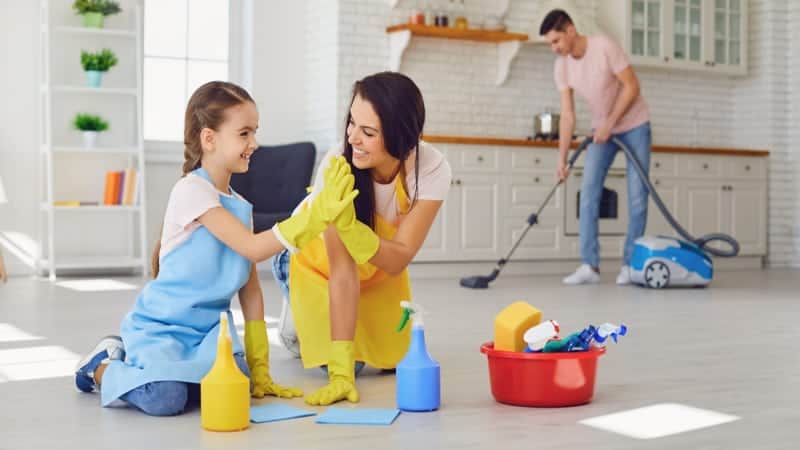Table of Contents
Taking Care of Your Home
Keeping your home clean and tidy is an important responsibility. A well-cared for house keeps your family healthy, prevents damage, and makes your home nicer to live in. In this lesson, we will learn about the equipment, tasks, and guidelines that help us take good care of our house.

Why It’s Important to Take Care of Your House
Your home is very important for you and your family. It does many important things for everyone living there.
Taking good care of your home is very important. Here are some reasons why:
- To keep it looking nice and clean
- To have good hygiene and health
- To stop germs and bugs from living there
- To make your furniture, carpets, and other items last longer
- To keep your home safe and working properly
SEE ALSO: Maintenance of the various Rooms of a Family House
Equipment for Cleaning
- Brooms – For sweeping floors and patios
- Brushes – For scrubbing surfaces and cleaning lint/dust from fabric items
- Mops – For washing floors and wiping down tile surfaces
- Buckets – For holding cleaning solutions and water
- Sponges – For wiping and scrubbing
- Cleaning rags – For dusting and wiping up messes
- Vacuum cleaner – For cleaning carpet and upholstery
Brooms and Brushes
Brooms are made from materials like palm leaves. Brushes can be made from horse hair, plant fibers, or plastic.
There are different kinds for different jobs:
- Short brooms and brushes – for sweeping floors
- Long, soft brooms and brushes – for cobwebs on walls and ceilings
- Stiff brooms and brushes – for outside sweeping
- Toilet brushes – for cleaning the toilet
- Stiff brushes – for carpets and rugs
- Polishing brushes – for shining shoes and other items
How to Choose Good Brooms and Brushes
- Pick the right one for the job
- Make sure they are good quality
- Check that handles are smooth and a good length
- Bristles should be tightly packed and firm
Caring for Brooms and Brushes
- Shake out dirt after using
- Wash in warm soapy water
- Rinse in clean water
- Hang up to dry
- Store properly when not in use
Dusters or Dust Cloths
Dusters or Dust cloths are made from soft, lint-free material.
How to Use Dust Cloths:
- Dry – for dusting
- Slightly damp – to pick up dust better
- Rub with dry cloth after damp dusting to polish and shine
Choosing Good Dust Cloths
- Soft and lint-free
- Absorbent
- Have multiple cloths
Caring for Dust Cloths
- Shake out loose dust after using
- Wash with soap and water
- Rinse and hang up to dry
Mops
Mop heads are made from twisted cotton attached to a handle.
- Dry mops – for dusting
- Wet mops – for washing floors
- Long handles allow you to stand while mopping
Caring for Mops
- Wash with soap after each use
- Rinse thoroughly
- Wring out water and hang to dry
- Wash mop bucket too
Other Cleaning Tools
- Dust pans or parker – for gathering swept up dust and dirt
- Buckets – for carrying water
- Garbage bins – for trash disposal
Daily, Weekly, and Seasonal Cleaning
To clean your home, you’ll need to sweep and dust all the different areas and surfaces. This includes rooms like the living room, kitchen, bedrooms, bathroom, etc.
Sweeping and Dusting
Cleaning means removing dust, dirt, stains, and anything else that doesn’t belong. The main methods are sweeping and dusting.
What is Dust?
Dust is fine, dry, loose particles in the air, like powdered dirt or plant and animal bits.
Facts About Dust:
- Settles easily on surfaces
- Sticks to damp areas
- Gets trapped in greasy or rough areas
- Easier to remove from smooth areas
- Greasy dust is harder to remove than loose dust
What is Dirt?
Dirt is dust that has gotten stuck from moisture, grease, or rough surfaces. It takes more than just dusting to remove it. You need water or cleaning solutions.
How to Dust
Use a cloth or duster to remove dust from surfaces.
Dusting Guidelines:
- Use clean dusters
- Work from top to bottom
- Carefully gather dust into cloth
- Frequently shake duster outside
- Don’t let dust blow back in
- Polish wood along the grain
- When finished, shake out duster thoroughly
Sweeping Guidelines:
- Use a good broom
- Sprinkle water first for very dusty floors
- Sweep towards the door, getting corners
- Prevent dust clouds by closing windows
- Gather dust piles with dustpan
- Wrap dust in newspaper and put in garbage
- Use short, even strokes
Daily and Weekly Cleaning
A dirty home can breed germs and bugs. Daily and weekly cleaning is important.
Daily Cleaning:
- Removes surface dust
- Done by sweeping and dusting
Daily Cleaning Rules:
- Gather cleaning tools and materials
- Sweep all rooms
- Remove cobwebs
- Sweep floors and corners
- Brush carpets
- Dispose of dust properly
- Dust furniture
- Neatly arrange furniture
- Change or add water to flowers
- Clean duster and put away
Weekly Cleaning:
- More thorough than daily
- Done on weekends when more time
Weekly Cleaning Guidelines:
- Gather cleaning tools and supplies
- Decide cleaning order and routine
- Open windows and doors to air out
- Move small items and furniture as needed
- Clean curtains and windows
- Remove all dust, getting corners
- Dust all furniture and fixtures
- Polish wooden furniture
Seasonal Cleaning
Some cleaning should be done each season:
- Wash or dry clean curtains
- Clean carpets and rugs
- Polish furniture
- Clean out closets
- Clean food storage areas
Disposing of Household Trash
Families make different types of waste from food scraps, cans, bottles, paper, ashes, etc. This needs to be disposed of properly to keep our homes and environment clean and safe.
Problems from improper trash disposal:
- Clogged drains
- Breeding grounds for bugs and pests
- Air pollution from rotting trash
- Attracts rats
- Causes accidents
- Looks messy and dirty
- Can spread disease
Trash Cans and Bins
Cans and bins come in different sizes, colors, and materials like metal, wood, or plastic. Consider:
- Family size
- Types of trash
- Quality
- Cost
Good Trash Can Features:
- Sturdy and durable
- Tight fitting lid
- Strong handles
- Leak proof
- Drainage holes in bottom
Caring for Trash Cans:
- Rinse each time it’s emptied
- Scrub weekly with soap and disinfectant
- Scour with cleaner or ash if needed
- Rinse with disinfectant
- Dry in sun
Other tips:
- Keep lid closed
- Empty regularly
- Wrap food waste in newspaper
- Replace when worn out
- Use smaller kitchen can and larger outdoor can
Ways to Dispose of Trash
How you dispose of trash depends on the type and your household:
- Bury non-biodegradable items like glass, cans, etc if you have land space
- Burn dry paper, leaves, rags where allowed
- Feed food waste to animals
- Compost vegetable and some animal waste
Sorting Trash
- Separate types of trash into different containers for proper disposal



